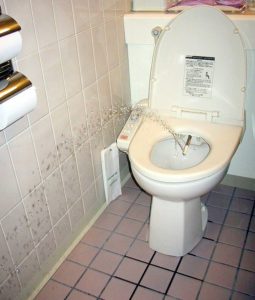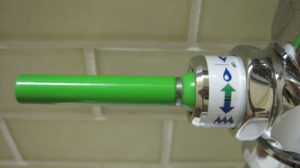COVID-19 Toilet Paper Shortage and 6 Ways to Embrace Eco-Friendly Bathroom Habits
My prior post was about ways to handle COVID-19 anxiety through connecting with nature. If you are feeling anxious, upset, or groundless, please read that post instead of this one. Another way to handle difficult emotions is through humor. Using humor in this way does not diminish the seriousness of the situation, but rather gives us a brief respite from the bad news and a reason to crack a smile. Here is some levity for your enjoyment:

Toilet paper shortages are now ubiquitous in the apocalyptic COVID-19 world. Supermarket shelves once filled with TP of varying sizes and plushness are bare, just like the bums of ours in need of a wipe. Sold for an upcharge, TP flies off of the warehouse shelves of online retailers – even the usually neglected, sandpaper-y single ply kind.
The toilet paper shortage forces us to ask some existential questions. Who the hell is buying all of this toilet paper? How much toilet paper does one require to sustain life?
And the most dire of all questions – How do we survive in a world without toilet paper?
Dear readers, I think I have some answers. They may not be easy to stomach, but they will get us through.
1. Pee Rag
For going #1, the economical and eco-friendly option is the pee rag. Unknown to all in the civilized world except the granola-crunching backwoods trail crowd, the pee rag is a staple of long distance backpacking (for females, anyway). Who wants to dig a hole to bury TP or find a leaf of questionable origin and often disappointing thickness when you can just tinkle and be done with a quick sweep of the trusty pee rag? Hanging dutifully on your backpack, drying in the sun, it is virtually an infinitely renewable resource. You can buy a really cute one like this, or you could just re-purpose some scrap material you have at home. Some adjustments may need to be made to use it indoors: does this rag belong on the shower door rack? Over the side of the tub? Hanging on a towel hook? To rinse or not to rinse…?
2. Go Toilet Paper and TP-substitute Free
This is another one common to those of us females who can tolerate some dirt and grime in the woods. Don’t have male anatomy? Pretend! Act like a dog coming out of a bath and give a good shake. Pair this with moisture wicking antimicrobial wool underwear, and you are good to go. You probably don’t need to report to an office and aren’t encouraged to be in public spaces, so who cares if you are a bit fragrant?

3. Hate Option 1 and 2? Try the Bidet
The upscale, bourgeoisie version of going toilet-tissue-less is to purchase a bidet. A ubiquitous household fixture in Japan as well as some European countries, the bidet can come with many features: an adjustable sprayer with heated water, warm air for drying, and some even come with heated seats, night lights, and UV sanitized sprayers! Not looking to drop half a grand on a bidet in this economy? Opting for the common man’s bidet (sans air dryer, heated seat, night lights, and UV sanitizers) and it only costs about $100. Pair with a pee rag, which will now serve as a bidet water wiping cloth. Sounds fancy, right?

4. Pee in the Shower
This suggestion has the power to divide families and friends into the “How could you do that?” and the “What’s wrong with it?” camps. Pro-shower-peers will tout the convenience of this option to relieve yourself and immediately clean yourself after. This suggestion has the potential to be environmentally friendly by reducing toilet paper usage and cutting water use from flushing, according to this article. While you probably shouldn’t hold your pee until you shower each day, you can combine this with other options to save some TP.
5. Use the Facili-trees
I wish I could take credit for thinking of that phrase, but I’m just not that creative. If you have a big yard, who’s to stop you from answering the call and communing with nature at the same time? You can collect the remaining fall leaves or new leaf growth if you have early plants or tree bark for an au naturale wiping experience. If you exhaust your supply of fresh leaves, you can even use smooth rocks or sticks – desperate times call for desperate measures. Do be certain what types of leaves you are picking, otherwise you will end up in need of some Calamine lotion with your TP. Your neighbors and municipality might frown upon this option, so doing it sparingly may be prudent. The best practice would be to bury your waste in a hole 6 inches or deeper. 
~ * ~ * ~
Hopefully you have found some toilet paper in the store or are able to barter with your neighbors for a few rolls and won’t have to employ these options. Joking aside, here are 6 ways to making going to the bathroom more green:
1. Install a Low-Flow Toilet or a Dual-Flow Option
Don’t waste large bowls of water on liquid waste. Older toilets use an average of 3.6 gallons of water for each flush, and some can use considerably more. Toilet flushing accounts for 31% of household water consumption, so any effort to limit this saves water and your wallet. Either install a new low-flow toilet or install one that you can choose between low flush volume for going #1 and normal flush for going #2.

2. Remember the Rhyme: “If it’s yellow, let it mellow; if it’s brown, flush it down.”
Just like it sounds, if you peed and you or a housemate intend to pee again in an hour or so, save the flush! Recommended in California to save water during drought, this article did the math – one standard low flow toilet flush (1.6 gallons) to flush roughly 8 ounces of urine wastes 3 days worth of drinking water (the recommended 68 ounces per day x 3) for each flush. However, you may find that you have to clean your toilet more frequently with this method. And remember, if it’s brown, definitely flush it down!
3. Install a Bidet
Yes, this can save on TP and increase comfort. An added benefit of using a bidet would be the elimination of those “flushable” wipes, which despite their supposed ability to break down often doesn’t happen fast enough and clogs municipal water systems. This method could increase your water usage, so use it judiciously. 4. Install a Composting Toilet Eschew the toilet fed by municipal potable water (a huge waste of purified water you drop excrement in) and install a composting toilet. This has the added benefit of generating compost from your human manure that can actually regenerate the health of the soil. According to this article, using a composting toilet can save as much as 6,600 gallons of water per person each year!

5. Use Less TP on Each Wipe
Are you a folder or a baller? As a reforming baller, I am trying to be mindful of the number of squares I grab before wadding them into a giant pile. Fold, don’t ball. Some say 3 squares are all you need, but that depends on how plush your toilet paper is.
6. Use Forest Stewardship Council – Certified Sustainable Toilet Paper
If you want to stick with the regular paper products – and I don’t blame you if you do – use ones that were harvested sustainably and don’t irresponsibly deplete natural resources. The Forest Stewardship Council certifies that companies protect natural habitats, reforest areas they harvest, and prevent pollution during their operation. Trees are an important source of carbon sequestration and we need them to keep ourselves and our planet happy. According to the FSC site (you have to enter your email to download the Consumer Shopping Guide), Scott, Charmin Ultra, Seventh Generation Purely Soft, Kirkland, and Green Action brand toilet papers are both FSC-certified. The surest way to find out is to check for the FSC-certified logo on the packaging.

~ * ~ * ~
I hope you found this list enjoyable, humorous, and also informational. Make it a goal to see how long you can make one roll of TP last during this quarantine – challenge your housemates or friends to see who can make it the longest! Or you can order a new toilet part online and install it while you are stuck at home with nothing better to do.
Do you have some other ideas on how to green up the bathroom? Share in the comments!
Stay healthy (and sane), folks!
